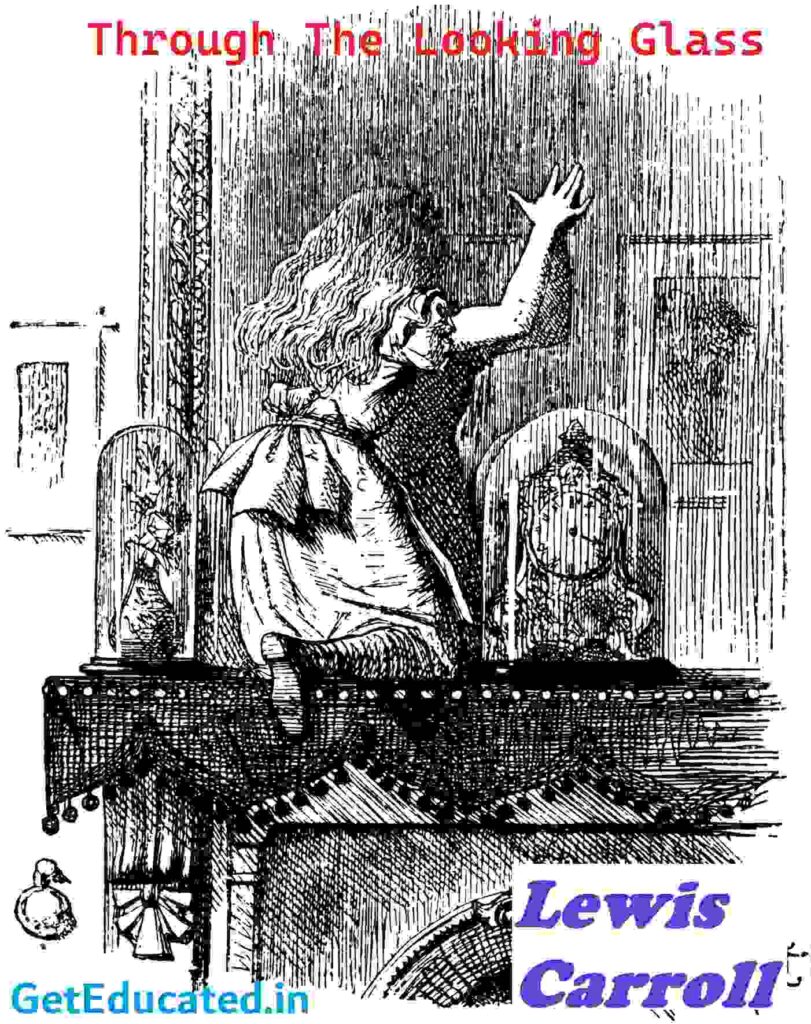
1. Analyse the Character of Alice in Through The Looking Glass.
Through the Looking-Glass and What Alice Found There, published in December 1871 (dated 1872), was written as a sequel to Alice’s Adventures in Wonderland by Lewis Carroll. Carroll first started this series as a form of communication with Alice Liddell, of whose parents he was a family friend. By the time Through the Looking-Glass was published, Alice was almost 20 years old, and Carroll’s close friendship with the Liddell family had weakened. His sequel can be seen as a fond farewell to Alice as she enters adulthood. Through the Looking-Glass follows a young Alice, six months older, on another adventure through an imaginary world. This world mirrors her own and like Wonderland is full of illogical behavior, tests, and lessons. Like its predecessor, Through the Looking-Glass introduces ideas about identity, confidence, discipline and so much more as Alice navigates this world laid out as a chessboard. Here, Alice, along with the inhabitants, are all pieces of one large game of chess, Alice’s ultimate goal becoming queen. She does succeed, but not without trial. Alice navigates this world almost effortlessly, and once awake those lessons she learned do not leave her. Her growth and maturity are what make this novel an interesting one to read as a Bildungsroman. Though Alice does not physically grow, her level of maturity develops well from start to finish. … (Read More)
2. Discuss Briefly the Tweedledum and Tweedledee Episode in Through The Looking Glass.
Tweedledum and Tweedledee are identical fat men and they stand with their arms around each other’s shoulders. Alice can tell them apart because one has “Dum” embroidered on his collar and the other has “Dee” on his She supposes that they must have “Tweedle” at the back of their collars but as she starts to move around them to look, Tweedledum says that she should pay if she’s going to treat them like waxworks Tweedledee says that she should speak. Alice apologizes and remembers an old song about Tweedledum and Tweedledee, in which the brothers fight over a rattle but forget their fight when a big crow flies too close The brothers say that they know what Alice is thinking about but it’s not true. … (Read More)
3. Examine the Nonsense Elements in Through The Looking Glass.
Through the Looking-Glass, and What Alice Found There (also known as Alice Through the Looking-Glass or simply Through the Looking-Glass) is a novel published on 27 December 1871 by Lewis Carroll and the sequel to Alice’s Adventures in Wonderland. Alice again enters a fantastical world, this time by climbing through a mirror into the world that she can see beyond it. Lewis Carroll’s sequel to Alice’s Adventures in Wonderland (1865), titled Through the Looking-Glass, and What Alice Found There (1871), takes the beloved Alice into a new world featuring a live game of chess, a few bizarre characters, and a repetition of classic nursery rhymes. While nonsense proves to be the bread-and- butter of Lewis Carroll’s writing style, it is not without purpose; the narrative structuring of the chess game and Alice’s pursuit of queenhood, coupled with the exchanges with the various characters, fall in line with a classic coming of age tale, and present Alice as a figure within a Bildungsroman. … (Read More)
4. Analyse the Character of the Red Queen in Through The Looking Glass.
Charles Lutwidge Dodgson (1832-1898), better known by his pseudonym Lewis Carroll, was not only an author but a keen observer of human nature. His most famous works are Alice’s Adventures in Wonderland and its sequel Through the Looking Glass, which have become timeless classics. The Red Queen is a fictional character in Through the Looking-Glass. She is the first queen to meet Alice, and also one of the first characters to meet Alice besides the flowers. The queen comes across as rude, aloof, and too practical towards Alice like a typical Victorian governess. She is particular about manners as she reminds Alice to curtsy and marks her temntory well as she tells off Alice that all ways belong to her. “I don’t know what you mean by your way…. All the ways about here belong to me”. She is the antagonist of the novel because if Alice as the White Queen’s pawn, is the protagonist of the story, it naturally makes the Red Queen the villain of the novel. The Red Queen also has exceptional powers as a queen, she can run very fast and can go anywhere as she is the queen. … (Read More)
5. Examine the Fantasy Elements in Through The Looking Glass.
Through the Looking-Glass, and What Alice Found There (also known as Alice Through
the Looking-Glass or simply Through the Looking-Glass) is a novel published on 27 December 1871 by Lewis Carroll and the sequel to Alice’s Adventures in Wonderland . Alice again enters a fantastical world, this time by climbing through a mirror into the world that she can see beyond it. Lewis Carroll’s sequel to Alice’s Adventures in Wonderland (1865), titled Through the Looking-Glass, and What Alice Found There (1871), takes the beloved Alice into a new world featuring a live game of chess, a few bizarre characters, and a repetition of classic nursery rhymes. While nonsense proves to be the bread-and-butter of Lewis Carroll’s writing style, it is not without purpose; the narrative structuring of the chess game and Alice’s pursuit of queenhood, coupled with the exchanges with the various characters, fall in line with a classic coming of age tale, and present Alice as a figure within a Bildungsroman.
The lone subjective mind can never understand what constitutes absolute truth or reality. One cannot escape how his opinions and his single point of view distort and reshape reality,
transforming it into a personal reality. Lewis Carroll challenges this personal reality in Through the Looking Glass by using the genre of fantasy. He confronts the reader indirectly through Alice. As the foreign world through the looking glass disobeys Alice’s established views, so does it disobey the reader’s views. The Hatter’s imprisonment serves as a good example of this. The Queen explains, “‘He’s in prison now, being punished: and the trial doesn’t even begin till next Wednesday: and of course the crime comes last of all.’” (Through the Looking Glass, p. 151) Alice does not see the sense of this because, like us, she has the reverse view of reality from the looking glass people. She dislikes the idea that someone could be punished for a crime they did not commit, but to the Queen it makes perfect sense. This contrast of perspectives causes the reader to re-evaluate his own world, to question what he labels as unfair. On our side of the looking glass, people do occasionally get punished for something they did not do. Children are often reprimanded for a sibling’s misbehavior. In countries with strict governments, people who raise the suspicions of the government can be put in jail before they actually do anything to warrant it. Carroll makes us see the multiple examples of injustice in our own world by presenting that same injustice in a
different world where we can get a more objective view of it. … (Read More)
6. Discuss Briefly the Ending of the Novel, Through The Looking Glass.
The book ends with Alice encountering the White Queen and Red Queen, Alice is crowned a Queen herself because she reached the end of the chessboard. She then awakes in her home and wonders if she had dreamed these adventures or if she was actually the figment of someone else’s dream.
After realizing that she has become a Queen, Alice finds herself in the company of the Red Queen and the White Queen. The two queens begin questioning her relentlessly, telling her that she cannot be a queen until she passes the proper examination. They ask her strange questions about manners, mathematics, the alphabet, how to make bread, languages, and the cause of lightning. The Red Queen frustrates Alice by correcting every incorrect answer. Alice mistakenly remarks that thunder causes lightning, but when she attempts to reverse her statement, the Red Queen snaps that once she says something, she must live with the consequences. The White Queen changes the subject to a thunderstorm that occurred on the last set of Tuesdays. Confused, Alice listens to a sneering explanation that in Looking-Glass World, days are taken two or three at a time. The White Queen continues her foolish story, while the Red Queen apologizes to Alice for the White Queen’s behavior, explaining to Alice that the White Queen wasn’t brought up well. … (Read More)
